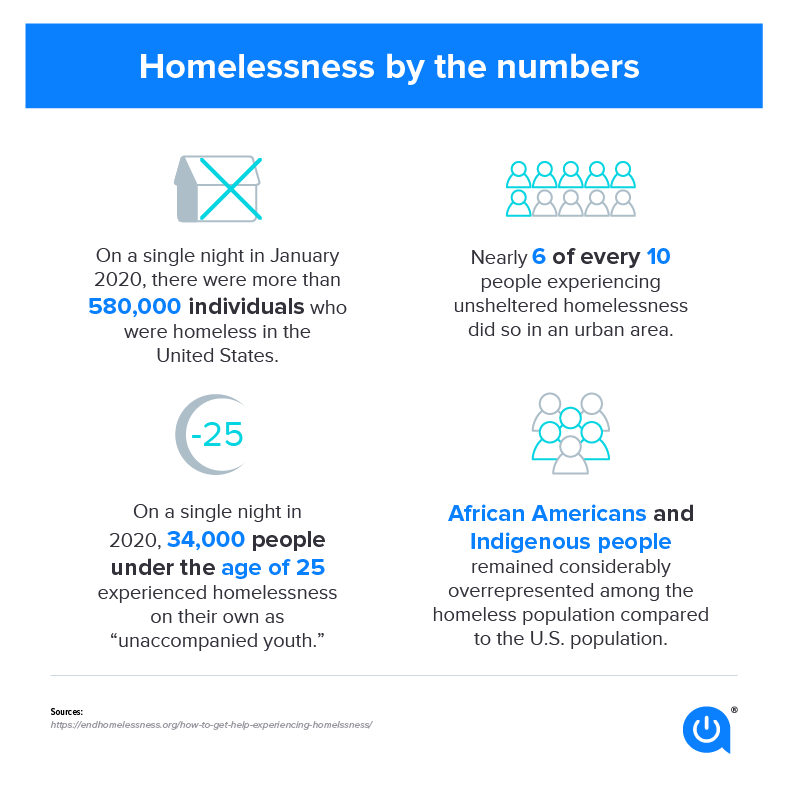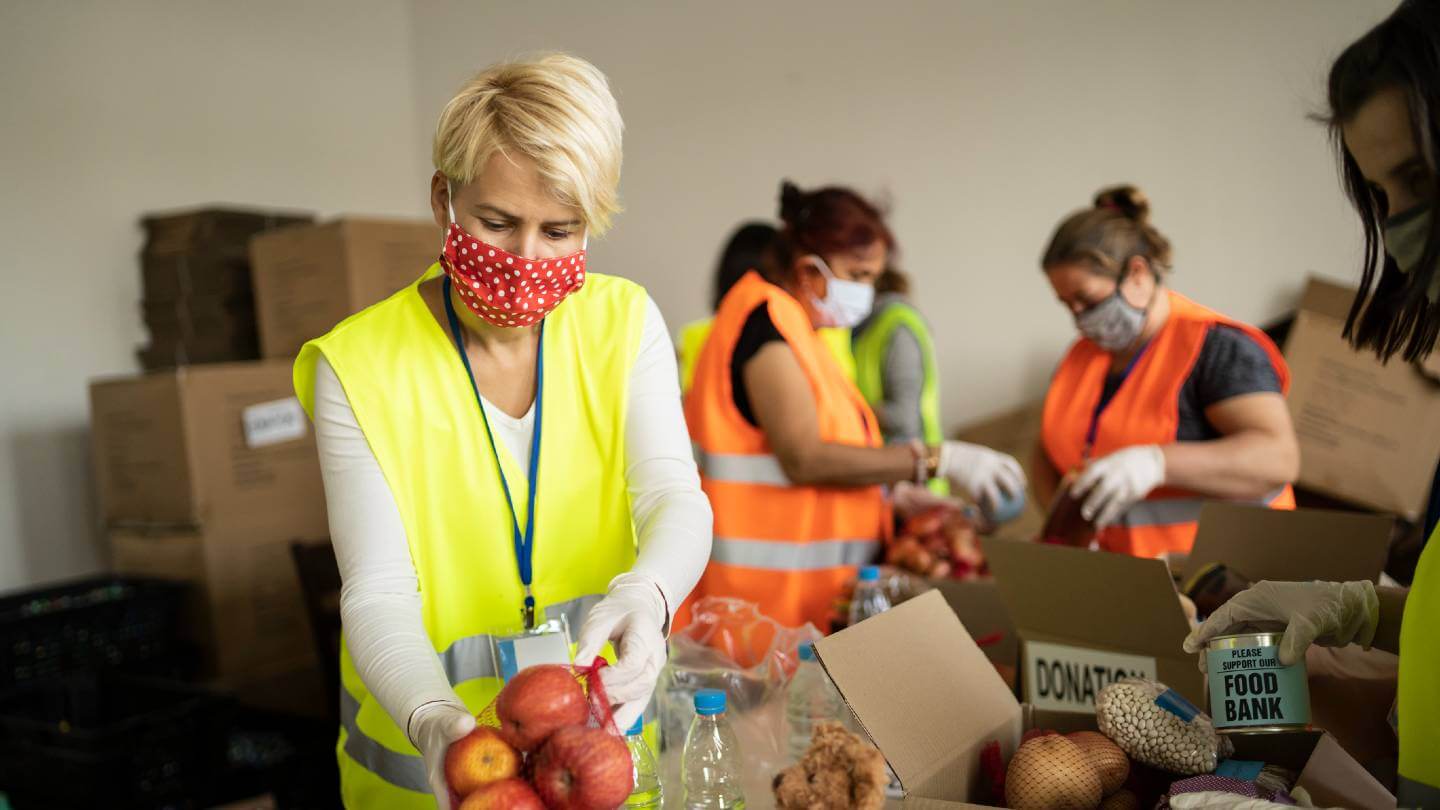Editor’s note:
As of 12/31/21, the Emergency Broadband Benefit has been replaced by the Affordable Connectivity Program. The monthly benefit has decreased from $50 to $30, plus a one-time discount of up to $100 to purchase a laptop, desktop or tablet. Anyone with an income at or below 200% of the Federal Poverty Guidelines is eligible.
It’s a cruel Catch-22: You need the internet to get your most basic needs met in 2021, but those who need it the most have the hardest time getting access to it.
For the fourth straight year in a row, the number of people experiencing homelessness rose in the United States in 2020. According to an annual nationwide survey by the Office of Policy Development and Research (OPDR), there were about 580K people living without traditional housing or in a temporary shelter last year — a 2.2% increase from 2019.
If that sounds low to you, it probably is. The report took a snapshot of homelessness in America in January 2020, before millions lost their jobs as a result of the COVID-19 pandemic.
“I can’t give you numbers,” said Secretary of Housing and Urban Development Marcia Fudge on the report. “We know that it increased; we just don’t know those numbers.”
With 1 in 7 Americans behind on rent and national eviction moratoriums set to expire at the end of June, the situation is likely going to get much worse before it gets better.

The group has already been particularly vulnerable to COVID-19, too. Research suggests that people who are homeless have physical conditions of people 15-20 years older than them, and 84% of unsheltered individuals self-reported existing physical health conditions. In almost every state, Black people, Pacific Islanders and Native Americans are overrepresented in the population of people experiencing homelessness.
View PDF of resources on homelessness and the digital divideHomelessness and the digital divide
While news stories around the digital divide usually focus on connectivity issues in rural America, the issue has a direct impact on people experiencing homelessness, too. According to a study from the University of Southern California, 1 in 3 people who are homeless reported no internet usage in the past three months — around five times the rate of the population at large.
And few groups need the internet as much as people without fixed residence. In 2019, the City Bar Justice Center conducted a survey of current and former family-shelter residents in Manhattan and the Bronx. Residents said that if the shelter had internet, they would use it for finding permanent housing (70%), finding a job (60%), finding medical care (63%) and accessing other benefits like unemployment, Supplemental Security Income, food stamps and Medicaid (45%).
“For homeless families, not having access to technology makes everything harder,” said Beth Vann-Turnbull, executive director at Housing Families First. “Apartment applications, utility applications, job applications, Social Services applications, bus schedules … everything has to be done online now. If you don’t have access to the internet, you’re at even more of a disadvantage.”
Youth experiencing homelessness and internet access
During a year of remote learning, staying connected to school has been an enormous challenge for families without fixed residence. According to the OPDR report, there were 172K people in families with children that were experiencing homelessness before the pandemic. Federal data from the National Center for Homeless Education shows that the number of enrolled students who have experienced homelessness at some point during the last three school years was at 1.5 million — and that was before the pandemic.
While we don’t know the exact numbers yet, it’s clear that the homelessness crisis has been deeply exacerbated by the pandemic. But it’s also made it easier for students who are homeless to slip through the cracks.
A recent report from SchoolHouse Connection and the University of Michigan says that an estimated 420K fewer children were identified as homeless and enrolled in school in fall 2020, compared with fall 2019. If all the evidence points to an increase in homelessness brought on by the pandemic, why was there a 28% decrease in the number of homeless students?
It’s actually a matter of counting. If students experiencing homelessness can’t go to school and can’t get a reliable internet connection to log on virtually, they’re simply not being identified as needing help.
![]()
The pandemic has significantly exacerbated the ongoing problem of under-identification and lack of services for homeless children and youth.
“Prior to the start of the COVID-19 pandemic, schools were failing to identify an estimated 1 million homeless children and youth,” the report says. “The COVID-19 pandemic has increased this number; as a result, as many as 1.4 million homeless K-12 children may be unidentified and unsupported by their schools.”
This under-identification can have devastating consequences for those students. While the federal government has invested trillions in response to the pandemic, that money often can’t find its way to the people who need it the most.
For example, the FCC’s $7 billion Emergency Connectivity Fund reimburses schools and libraries up to $400 for laptops or computers they provide for students. But if the administrators applying for funds don’t have an accurate idea of how many students in their area need those resources, they’re bound to be under-utilized.
What’s being done to bridge the gap?
The federal government has devoted more than $10 billion this year to expanding internet access for Americans. Here are some of the programs that are addressing the digital divide.
Emergency Broadband Benefit
The Emergency Broadband Benefit (EBB) authorized more than $3 billion in internet subsidies for low-income households. Anyone who qualifies will get $50/mo. off their internet bill. That said, it is a temporary program designed to keep people connected during the COVID-19 pandemic. Once the funds run out, households will have to go back to paying full price for internet. You’ll qualify for the subsidy if:
- Your gross household income is at or below 135% of federal poverty guidelines
- You already qualify for a program like Lifeline, Supplemental Nutrition Assistance Program (SNAP), Medicaid or a federal Pell Grant
- You experienced a substantial loss of income since Feb. 29, 2020 due to job loss or furlough, as long as your household income for 2020 was at or below $99,000 for single filers and $198,000 for joint filers
- You are approved for the free or reduced price school breakfast/lunch program, including through the USDA Community Eligibility Provision
- You live on Tribal lands
People experiencing homelessness can take advantage of the EBB if they meet one of the above criteria, even if they don’t have a fixed address. “They have a few different options,” says USAC’s Director of Communications, Jaymie Gustafson. “If there is a particular area [they’re staying], they can use that as a descriptive address. If there is a shelter where they are potentially receiving mail or other services, they can use those on their application.”
Emergency Connectivity Fund
The other major FCC program addressing the digital divide this year is the Emergency Connectivity Fund. This $7 billion program aims to keep students connected after in-person learning resumes.
It works by reimbursing schools and libraries for equipment like Wi-Fi hotspots, modems (including air cards), routers, devices that combine a modem and router and connected devices like laptops and tablets. The program will reimburse applicants a maximum of $400 for devices and $250 for Wi-Fi hotspots. It also covers internet connections for students at home.
How to find free internet in your area
In addition to these government programs, there are usually a few places in every community where anyone can access free Wi-Fi. Here are some of the most common places to look if you need to get online:
- Libraries
- Public parks
- City hall
- Visitor centers
- Airports
- Coffee shops
- Retail stores
You can also use tools like WiFi Map, which shows you all public Wi-Fi spots in your area.
Resources for people experiencing homelessness
In addition to the government programs above, there are a number of organizations across the country working to address homelessness. Here are some resources available to help family, friends, advocates and those who are experiencing homelessness.
Department of Housing and Urban Development resource locator
The Department of Housing and Urban Development (HUD) has a helpful resource locator tool on its website that can connect you with resources in your area. You can use it to do things like find affordable housing near you, locate a HUD office, find your local public housing authority and see what organizations are available to help locally.
You can also find a complete list of HUD resources in every community on their Homeless Assistance page. This includes both nonprofits and government agencies.
Transitional housing
There are several organizations and resources available that focus on bridging the gap between homelessness and permanent housing. Here are some good places to start looking:
- The Substance Abuse and Mental Health Services Administration released their Permanent Supportive Housing Evidence-Based Practices KIT which outlines essential components for transitional housing services and programs for people living with mental illness.
- TransitionalHousing.org put together a comprehensive database of over 6,563 transitional housing locations available in every state.
- The National Network to End Domestic Violence (NNEDV) provides a transitional housing toolkit for providers that addresses frequently asked questions, common challenges and best practices.
Resources for veterans
Veterans are about 50% more likely to experience homelessness than other Americans due to a lack of support and social isolation after discharge. Here are some resources that address veteran homelessness directly:
The Department of Veterans Affairs’ Homeless Programs has some of the most comprehensive resources targeting this issue. They can help connect veterans with housing solutions, healthcare, community employment services and other support systems. The National Call Center for Homeless Veterans is also available 24/7 at 1.877.4AID.VET.
Unemployment resources
More than 22 million people lost their jobs during the pandemic. Fortunately, extended unemployment benefits can help people stay on their feet during these hard times. Learn more about applying for unemployment benefits, disability insurance and workers’ compensation.
How you can make a difference
If you want to help people experiencing homelessness, there are a number of ways you can get involved. If you’re looking to volunteer your time, many of these have chapters around the country, but you can also find local groups and shelters through this directory.
Here are some of the top nonprofits we found in our research:
- National Alliance to End Homelessness: This group has a simple mission: To completely end homelessness in the U.S. With this as their North Star, they focus on providing permanent housing, rapid re-housing and the use of data to influence policy. You can support the organization by donating money or advocating for legislation that affects homelessness.
- PATH (People Assisting the Homeless): PATH follows the Housing First model — the belief that you need to provide people with safe housing before you can address other goals. The group works in 140 cities around California, and you can get involved by working in one of PATH’s kitchens, participating in a donation drive or doing admin support.
- Robin Hood Foundation: The largest poverty-fighting nonprofit in New York City, the Robin Hood Foundation partners with over 250 organizations around the city to provide food, housing, education, legal services and workforce development. All overhead is paid by its board of directors, so 100% of your donation goes directly to organizations on the ground.
- HomeAid: One of the largest national nonprofits addressing homelessness, HomeAid partners with shelters around the country to help build new spaces for those they serve. Over its 30 year history, HomeAid has helped develop more than 550 housing projects. You can donate money directly to the organization or volunteer at one of its 19 local chapters.
- National Coalition for the Homeless (NCH): The NCH is a national network of people and organizations that are working to end homelessness. The group conducts extensive research on the issue and lobbies the government for policy changes. You can donate to the NCH directly, and it also has a helpful directory of organizations across the country if you’re looking to get involved more locally.
Allconnect: Let us compare providers for you
Why should you choose Allconnect? We’re the #1 broadband marketplace in the U.S, meaning you can trust us to search, compare and order internet and TV service for your home.
Get started

Written by:
Joe SupanPrincipal Writer, Broadband Content
Joe is a senior writer for CNET covering home technology and broadband. Prior to joining CNET, Joe led MYMOVE’s moving coverage and reported on broadband policy, the digital divide, and privacy issues for the br…
Read more
Edited by:
Robin LaytonEditor, Broadband Content
-
Featured
![LGBTQ youth resources: Bridging the digital divide]() LGBTQ youth resources: Bridging the digital divide Robin Layton — 10 min read
LGBTQ youth resources: Bridging the digital divide Robin Layton — 10 min read -
Featured
![Can a mobile device replace your home internet?]() Can a mobile device replace your home internet? Robin Layton — 6 min read
Can a mobile device replace your home internet? Robin Layton — 6 min read -
Featured
![A community guide to advocating for better broadband services]() A community guide to advocating for better broadband services Ari Howard — 7 min read
A community guide to advocating for better broadband services Ari Howard — 7 min read
Latest
-
Wednesday, October 23, 2024
What is my IP address and why does it matter?Camryn Smith — 3 min read
-
Tuesday, October 22, 2024
Everything you need to know about internet speedsRobin Layton — 5 min read
-
Tuesday, October 22, 2024
How to change your Wi-Fi network passwordCamryn Smith — 3 min read






